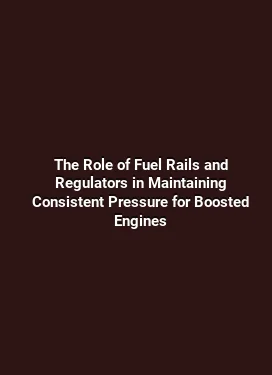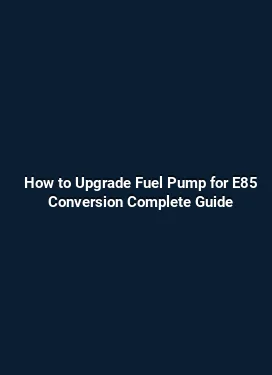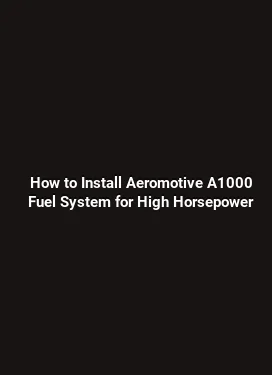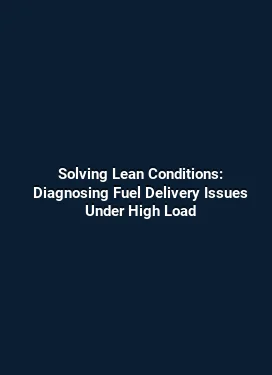Best Fuel Pressure Regulator Settings for Forced Induction Engines
Forced induction engines rely on precise control of fuel delivery to maintain optimum air-fuel ratios under boost. The fuel pressure regulator (FPR) is a key component in shaping the rail pressure and, consequently, the injector flow across different operating conditions. This guide dives into practical settings, tuning approaches, and common scenarios to help drivers and technicians extract reliable performance while preserving engine health.
Fundamentals of Fuel Pressure Regulation in Boosted Applications

In forced induction systems, the fuel pressure regulator establishes the baseline rail pressure and how it responds to changes in boost. A regulator that maintains consistent rail pressure as the intake manifold pressure rises is essential for predictable injector performance. The dynamic relationship between rail pressure, injector flow, and boost dictates the actual fuel delivery. When boost increases, the regulator must accommodate higher head pressure to keep the injector opening times consistent, preventing leaned or rich conditions that can harm power and reliability.
Key concepts include rail pressure setpoint, the fuel pressure ratio relative to manifold pressure, and the regulator’s ability to minimize pressure drop across the injector. Modern systems frequently use return-type regulators or external baffled regulators in conjunction with a dedicated fuel pump and efficient wiring. The goal is to achieve a stable, predictable fuel curve that tracks the engine’s torque demands without introducing oscillations or lag in response.
Baseline Setup: Establishing a Safe Yet Capable Rail Pressure
Choosing a starting point for naturally aspirated vs. boosted setups

For boosted engines, begin with a baseline rail pressure that is higher than the stock setup by a defined boost ratio. A common starting point is rail pressure roughly 1.5 to 2.0 times the manifold boost pressure plus the base engine rail pressure. For example, with 12 psi of boost and a stock rail baseline of 40 psi, a starting rail pressure might be in the 60–70 psi range. This baseline helps ensure adequate injector flow at the edges of the boost curve while leaving room for refinement based on observed air-fuel behavior.
In high-boost applications, it is crucial to verify the regulator’s capacity to maintain pressure under transient loads. If the regulator is undersized or the return line is too restrictive, rail pressure can sag during peak torque, causing injector nonlinearity and potential detonation. Conversely, overly high rail pressure can reduce injector efficiency and increase fuel rail heat, so balance is essential.
Interdependencies: Boost, Injector Size, and Fuel Pump Capacity
Injector flow, spray pattern, and open time under boost
Injector size defines the maximum flow at a given rail pressure. When rail pressure rises, the same injector can deliver more fuel per cycle, but the engine management must account for the fuel’s added latency and spray pattern. A larger injector paired with a higher rail pressure may provide ample top-end fueling, but mid-range fueling can suffer if the regulator or pump cannot respond quickly enough to transient changes. Balancing injector flow with rail pressure avoids lean spikes during throttle transitions.
Fuel pump capacity also interacts with regulator behavior. A pump that cannot sustain the target rail pressure at high duty cycles will cause pressure drops, leading to fuel starvation at the moment of peak torque. Selecting a pump with sufficient head pressure and appropriate electrical support is a practical safeguard when running aggressive boost levels.
Adjustable Fuel Pressure Regulators vs Fixed Regulators
When to choose adjustability and how to dial it in
An adjustable regulator provides the flexibility to tailor rail pressure as boost evolves or as fuel properties change (temperature, ethanol content, or fuel density). The tuning approach starts with a conservative target rail pressure that ensures injector responsiveness at idle and part-throttle operation. Gradually raise rail pressure in small steps (e.g., 2–5 psi per session) while monitoring target air-fuel ratios, knock resistance, and temperature behavior. Adjustments should be coupled with real-time data such as wideband readings and, if available, injector duty cycle and fuel trim feedback from the ECU.
For engines running ethanol blends or high-octane race fuels, compensation strategies may include a slightly higher rail pressure to maintain injector margins at high lambda values. Always confirm that the fuel return line and hose junctions are rated for the pressure range to avoid leaks or hose fatigue.
Practical Tuning Steps: A Structured Approach
Step-by-step method to tune rail pressure under boost
1) Establish baseline: Set the regulator to stock rail pressure plus a modest boost offset. Test at light throttle and at a handful of mid-range boost levels to observe fuel trims and AFR stability.
2) Expand coverage: Increase boost gradually while watching AFR and injector duty cycle. If AFR drifts rich at WOT, consider slightly increasing rail pressure to promote finer control of injector flow. If it drifts lean, you may need to raise rail pressure or adjust the pump duty cycle to improve fuel delivery at higher engine loads.
3) Validate response: During transient throttle changes, ensure the fuel system responds quickly enough to maintain a stable AFR. A sluggish regulator can lead to temporary lean spikes, which are particularly dangerous under boost. If you observe hesitation or retarded timing, recheck fuel pressure response and hose routing for potential vacuum leaks in the intake manifold area nearby the regulator.
4) Confirm safety margins: Keep a margin of headroom between rail pressure and the regulator’s maximum rating to avoid creeping pressure that can stress injectors or fuel lines. This is especially important in engines with aggressive cam timing or high-load torque curves.
Common Pitfalls and How to Avoid Them
Identifying and correcting rail pressure instability
Rail pressure that fluctuates during acceleration is often caused by a combination of inadequate regulator capacity, poor fuel supply, or vacuum leaks. Check the routing of the vacuum reference line to ensure it’s not influenced by unmetered vacuum sources. Ensure the return line diameter is sufficient to prevent backpressure that reduces regulator effectiveness. When pressure dips occur, verify that the pump is delivering the required volume and that the wiring harness is providing clean, stable power to avoid voltage dips that could limit pump speed.
Another common cause is injector timing mismatch or miscalibration. If the ECU maps do not align with the regulator’s output under boost, the system may oversupply or undersupply fuel. This is particularly evident in engines that switch between pump modes or experience fuel temperature changes due to proximity to exhaust components.
Fuel Temperature, Ethanol Content, and Dynamic Behavior
How fuel properties affect regulator settings
Fuel temperature directly impacts density and viscosity, which in turn influence injector flow characteristics at a given rail pressure. Warmer fuel can flow more easily, potentially reducing effective pressure at the injector tip if the regulator does not maintain consistent pressure upstream. Ethanol blends alter oxygen content and stoichiometry, often demanding a richer baseline across the operating range. When ethanol content increases, you may benefit from a modest rail pressure increase to preserve injector margin and prevent lean symptoms during peak boost.
Regular monitoring of fuel rail temperature and ambient conditions helps technicians adjust settings to maintain a stable air-fuel ratio. In high-performance builds, integrating a temperature-compensated regulator or tracking fuel temperature with the ECU can smooth out sudden changes and improve consistency during prolonged pulls.
Instrumentation and Diagnostics: What to Watch
Tools and data streams that guide regulator tuning
Effective tuning relies on accurate, interpretable data. A wideband O2 sensor provides real-time feedback on the air-fuel ratio, while a fuel pressure gauge or inline sensor confirms the regulator’s output under various conditions. Monitoring injector duty cycle and flow rates helps ensure the regulator is not forcing a mismatch between the injector’s capabilities and the engine’s demand. A data logger that captures RPM, load, boost, fuel pressure, AFR, and knock events allows for pattern recognition and more precise tuning adjustments.
EMI-free sensor placement and robust electrical connections are essential for stable readings. In noisy electrical environments, adding shielded wiring and proper grounding reduces the risk of erroneous data guiding tuning decisions. Regularly verify sensor calibration to prevent drift from skewing the tuning process.
Maintenance, Durability, and Reliability Considerations
Preserving regulator performance over time
Fuel system cleanliness is critical. Contaminants can cause regulator diaphragms to wear or seize, leading to erratic pressure behavior. Incorporate fuel system cleanliness practices, such as using high-quality filters and regularly inspecting hoses for cracks or stiffness. When upgrading to higher rail pressures, ensure hoses, clamps, and fittings are rated for the increased stress to mitigate leaks and pressure drops.
Inspect the regulator’s mounting and vacuum reference lines for leaks, which can undermine reference pressure and cause fluctuations. A well-sealed system maintains consistency across temperature cycles and engine operating modes, reducing the risk of AFR instability or injector malfunctions during high-load events.
Advanced Scenarios: Race-Plan Specific Adjustments
When running extreme boost or methanol/wuel-based fuels
In extreme boost regimes, some teams opt for a dedicated, high-flow regulator coupled with a separate feed line for a surge tank. This configuration minimizes pressure drop during rapid throttle changes and ensures the regulator’s reference pressure tracks the manifold pressure without overshooting. Methanol and other specialty fuels often require recalibrated pressure targets due to their different stoichiometry and vapor pressure characteristics. In these cases, maintain an emphasis on ensuring the regulator can sustain pressure under high duty cycle without overheating or shrinking its response window.
When using returnless fuel systems, the regulator’s role shifts toward maintaining a stable rail pressure through careful pump selection and wiring. Ensure the return path is designed to minimize pressure pulsations and that the ECU’s fuel compensation strategies align with the regulator’s behavior under boost.
Practical Takeaways for Everyday Tuning
Key actionable guidelines to implement today
- Start with a conservative rail pressure that supports current boost levels and gradually raise it while tracking AFR and injector duty cycle.
- Prioritize regulator responsiveness to transient changes to avoid lean spikes during rapid throttle transitions.
- Confirm pump capacity is adequate for the chosen rail pressure and boost; a supported pump reduces the risk of pressure drop during peak torque.
- Use a reliable data-logging setup to correlate rail pressure, AFR, boost, and pump performance across the operating range.
- Inspect fuel system components for compatibility with boosted operation, ensuring hoses and fittings are rated for the target pressure range.
Conclusion: Integrating Regulator Settings into a Holistic Fuel Strategy
Effective fuel pressure regulation in forced induction engines is about maintaining a stable, predictable supply that matches the engine’s boost-driven demand. An adjustable regulator paired with careful pump selection, injector sizing, and monitoring delivers the precision needed for optimal power, reliability, and drivability. By methodically tuning rail pressure in concert with fuel properties, boost levels, and temperature considerations, enthusiasts can build a robust fueling strategy that performs under a wide range of conditions, from daily driving to track sessions.






